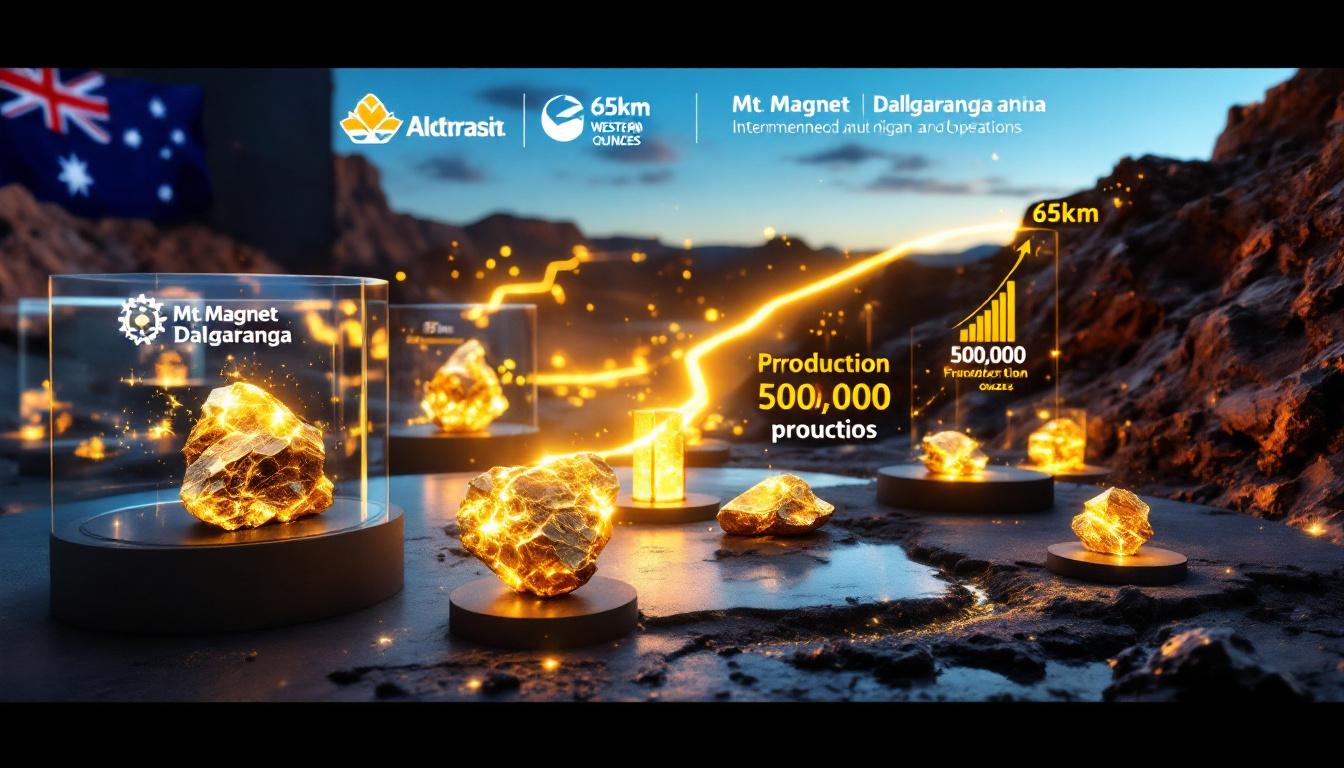MinRes Yilgarn Hub Sale: Strategic Transition and Future Implications
What is the Yilgarn Hub and Why Was It Sold?
The Yilgarn iron ore operations represent a cornerstone of Western Australia's mining history, with roots stretching back over 80 years. For the past 14 years, Mineral Resources (MinRes) has operated these assets as a key component of their diversified mining portfolio, establishing the operations as a significant contributor to the company's iron ore production.
One of the most notable achievements during MinRes's stewardship came in 2011, when the company took over the Koolyanobbing operation following Cleveland Cliffs' departure from the Australian market. This decisive move preserved hundreds of local jobs and maintained critical economic activity in the region during a challenging transition period.
"We take great pride in everything the MinRes team has achieved at our Yilgarn operations over the past 14 years, including saving hundreds of jobs at Koolyanobbing when we stepped in after Cleveland Cliffs' departure," noted Chris Ellison, Managing Director of MinRes.
The strategic rationale behind MinRes's decision to divest the Yilgarn Hub is multifaceted and rooted in pragmatic resource economics:
- Limited remaining mine life at existing operations, with reserves reaching maturity
- Substantial capital expenditure requirements for developing new resource bodies
- Extended lead times necessary to bring new deposits online
- Strategic reallocation of capital toward higher-value, longer-life assets elsewhere in the portfolio
The decision reflects broader industry trends where major miners are increasingly focused on mining consolidation strategies around tier-one assets with decades of productive life remaining, rather than continuing to invest in mature operations with diminishing returns on capital.
Who Acquired the Yilgarn Hub Assets?
The sale to Yilgarn Iron Investments was officially finalized in June 2025, concluding a transaction process that began with the initial announcement in January of the same year. The comprehensive agreement included a substantial portfolio of assets and rights:
- All shares in Yilgarn Iron Pty Ltd
- Multiple tenements across the broader Yilgarn Hub
- Associated land interests and property rights
- Regulatory approvals and operating licenses
- Fixed infrastructure assets across the operations
Despite this extensive transfer of operational assets, MinRes implemented a strategic retention approach to certain mineral rights that could provide future value opportunities. The company maintained:
- All gold rights on applicable tenements within the Yilgarn Hub footprint
- All lithium rights on applicable tenements, preserving optionality as battery mineral demand continues to evolve
This selective retention strategy allows MinRes to maintain exposure to potential high-value commodities while divesting the capital-intensive iron ore operations. The approach exemplifies a growing trend in the mining sector of unbundling mineral rights to optimize portfolio value across different commodity cycles.
The commercial terms of the transaction remain confidential, though industry analysts have noted MinRes's emphasis on selecting a buyer committed to ongoing operations rather than maximizing short-term transaction value.
How Does This Sale Impact MinRes's Iron Ore Strategy?
The divestment of the Yilgarn Hub represents a pivotal moment in MinRes's broader iron ore strategy, triggering a significant workforce transition and operational realignment. According to the company's announcements, approximately 800 personnel have been affected by the change, with the majority successfully redeployed to other MinRes operations.
"Approximately 800 people have been relocated to other MinRes operations such as Onslow Iron, with export operations from Yilgarn ceasing at the end of 2024," reported Australian Mining in their coverage of the transaction.
This workforce transition highlights MinRes's commitment to retaining talent within the organization despite the divestment. The company's ability to absorb such a significant number of employees into other operations demonstrates the scale and growth trajectory of its remaining assets, particularly the expanding Onslow Iron operations.
The strategic refocusing of MinRes's iron ore portfolio is now concentrated on three core Pilbara-based operations:
- Onslow Iron development – The flagship growth project in the west Pilbara region
- Wonmunna operations – A producing asset in the central Pilbara
- Iron Valley mine – An established operation in the eastern Pilbara
This geographical consolidation in the Pilbara region offers significant operational advantages, including:
- Infrastructure synergies between proximate operations
- Logistics optimization across the supply chain
- Management efficiency through regional concentration
- Scale benefits in procurement and service provision
The shift represents a clear strategic pivot from the geographically dispersed model that included the Yilgarn operations to a more concentrated Pilbara-focused approach that aligns with the practices of major producers like Rio Tinto and BHP.
What is the Significance of the Onslow Iron Project?
The Onslow Iron project stands as the centerpiece of MinRes's reconfigured iron ore strategy, representing one of Australia's largest iron ore developments currently underway. This transformational project is set to unlock billions of tonnes of previously stranded iron ore deposits in the resource-rich west Pilbara region.
The scale and strategic importance of Onslow Iron cannot be overstated:
- Massive resource base – Estimated to contain multiple billion tonnes of iron ore
- Multi-decade mine life – Providing generational production potential
- Quality product specifications – Capable of meeting increasingly stringent market requirements
- Strategic location – Positioned with access to deep-water port infrastructure
The development encompasses comprehensive infrastructure requirements that extend far beyond traditional mining operations:
| Infrastructure Component | Strategic Significance |
|---|---|
| Port facilities | Enabling direct export capacity and reducing logistics costs |
| Rail networks | Connecting previously isolated deposits to export channels |
| Processing facilities | Upgrading ore quality to meet premium market specifications |
| Water management | Sustainable utilization of scarce regional resources |
| Power infrastructure | Supporting energy-intensive beneficiation processes |
This integrated approach to development represents a step-change in MinRes's operating scale and capabilities, positioning the company alongside major Pilbara producers. The multi-year development timeline aligns with projected increases in iron ore price trends from steel producers seeking alternatives to traditional suppliers.
Disclaimer: The development timeline and production targets for the Onslow Iron project remain subject to regulatory approvals, market conditions, and capital investment decisions. Investors should consult MinRes's official ASX disclosures for the most current information.
What Are the Regional and Economic Implications?
The structured approach to the Yilgarn divestment reflects MinRes's consideration of broader regional economic impacts beyond purely financial transaction metrics. Throughout the sale process, the company emphasized selecting a buyer committed to sustaining operations and preserving the regional economic benefits generated by the mines.
"This transaction ensures these mines will continue to support jobs and the regional economy in Western Australia," stated Chris Ellison in the company's ASX announcement.
The regional implications extend across multiple dimensions:
- Employment continuity – Preserving direct and indirect jobs in the Yilgarn region
- Local business support – Maintaining the supply chain ecosystem that has developed around the operations
- Community investment – Continuing social and infrastructure contributions
- Mining heritage preservation – Sustaining the region's multi-generational mining tradition
While the financial terms of the transaction remain confidential, industry analysts have noted MinRes's prioritization of long-term regional economic benefits over maximizing the immediate sale price. This approach aligns with growing expectations for mining companies to consider their social license to operate when making strategic portfolio decisions.
The transaction structure also reflects the Western Australian government's emphasis on responsible resource development and transition. The state's mining regulations increasingly consider the social and economic impacts of mine closures and ownership transfers, encouraging approaches that minimize disruption to regional communities.
What Does This Mean for MinRes's Future Direction?
The divestment of the Yilgarn Hub represents a significant milestone in MinRes's broader strategic evolution, reflecting a deliberate portfolio optimization approach focused on concentrating capital and management attention on higher-return assets with extended growth potential.
This strategic repositioning encompasses several key dimensions:
- Capital allocation efficiency – Directing investment toward assets with superior returns and longer operational horizons
- Operational streamlining – Reducing complexity by consolidating geographic footprint
- Core growth project focus – Concentrating resources on transformational opportunities like Onslow Iron
- Balanced commodity exposure – Maintaining diversification across iron ore, lithium, and other minerals
From a leadership perspective, MinRes Managing Director Chris Ellison has framed the transaction in terms that emphasize both pride in past achievements and confidence in future direction:
"We transfer our Yilgarn operations with pride in what we've accomplished over the past 14 years, satisfaction in having preserved jobs after Cleveland Cliffs' departure, and confidence that these assets will continue delivering ongoing benefits to Western Australia's economy."
The company's retention of gold and lithium rights across applicable Yilgarn tenements signals an ongoing strategic interest in maintaining optionality around these commodities, even as it exits the region's iron ore operations. This selective approach to mineral rights demonstrates a sophisticated understanding of commodity-specific value drivers and future market opportunities.
Industry analysts view this transaction as part of a broader trend among mid-tier miners toward portfolio rationalization – focusing on fewer, larger assets where they can establish competitive advantages rather than maintaining diverse operations across multiple regions and commodities. Furthermore, MinRes's retention of gold rights aligns with the strong gold market performance seen recently, while their interest in lithium positions them well within Australia's broader critical minerals strategy.
Disclaimer: This analysis represents current understanding based on publicly available information. Future strategic decisions by MinRes will depend on market conditions, commodity prices, and company-specific factors that may evolve over time.
FAQ: Key Questions About the MinRes Yilgarn Sale
Why did MinRes decide to sell the Yilgarn Hub?
The decision was driven by a combination of operational and strategic factors:
- Limited remaining mine life at existing operations
- Significant capital expenditure requirements to develop new resources
- Extended lead times needed to bring new deposits online
- Strategic shift toward higher-value assets elsewhere in the portfolio, particularly the Onslow Iron project
These factors collectively pointed toward reallocating capital and management focus to longer-life assets with superior returns on investment.
What assets were included in the sale?
The comprehensive transaction included:
- All shares in Yilgarn Iron Pty Ltd
- Multiple tenements across the Yilgarn Hub
- Associated land interests and property rights
- Regulatory approvals and operating licenses
- Fixed infrastructure assets across the operations
The sale effectively transferred the entire operational footprint of the Yilgarn iron ore business to the new owner.
What mineral rights did MinRes retain?
MinRes strategically retained:
- All gold rights on applicable tenements within the Yilgarn Hub
- All lithium rights on applicable tenements
This selective retention preserves future optionality in these commodities without requiring ongoing capital investment in iron ore operations.
How many employees were affected by the sale?
Approximately 800 personnel were relocated from the Yilgarn operations. The majority were transferred to other MinRes operations, with the developing Onslow Iron project absorbing a significant proportion of the workforce. This approach minimized job losses while reallocating skilled labor to growth projects.
When did MinRes cease exports from the Yilgarn Hub?
Export operations from the Yilgarn Hub were discontinued at the end of 2024, approximately six months before the finalization of the sale in June 2025. This phased approach allowed for an orderly transition of operations while MinRes reallocated personnel and resources to other projects.
What is the strategic significance of MinRes retaining gold and lithium rights?
The retention of these mineral rights represents a strategic hedge that:
- Preserves exposure to potential high-value discoveries without ongoing operational costs
- Maintains optionality in commodities with different market cycles than iron ore
- Allows for future development or partnership opportunities if significant resources are identified
- Reflects the growing importance of battery minerals in MinRes's broader portfolio strategy
This approach exemplifies modern mining portfolio management, where companies increasingly unbundle mineral rights to optimize value across different commodity cycles.
Interested in Investing in the Next Big Mineral Discovery?
Discover significant ASX mineral discoveries as they happen with Discovery Alert's proprietary Discovery IQ model, giving you an immediate edge in the market. Explore our dedicated discoveries page to understand how major mineral discoveries have historically generated substantial returns for investors.




